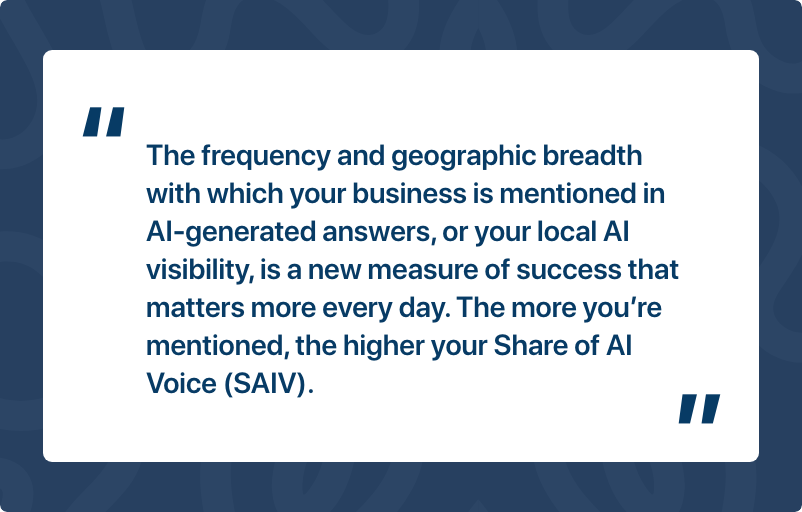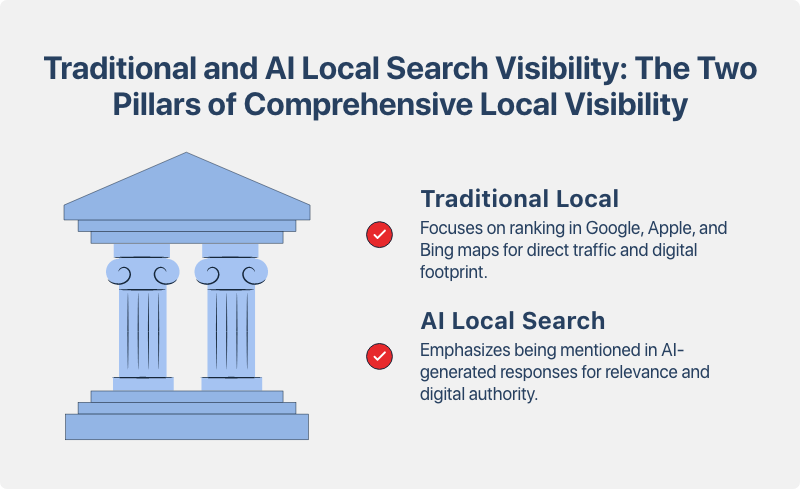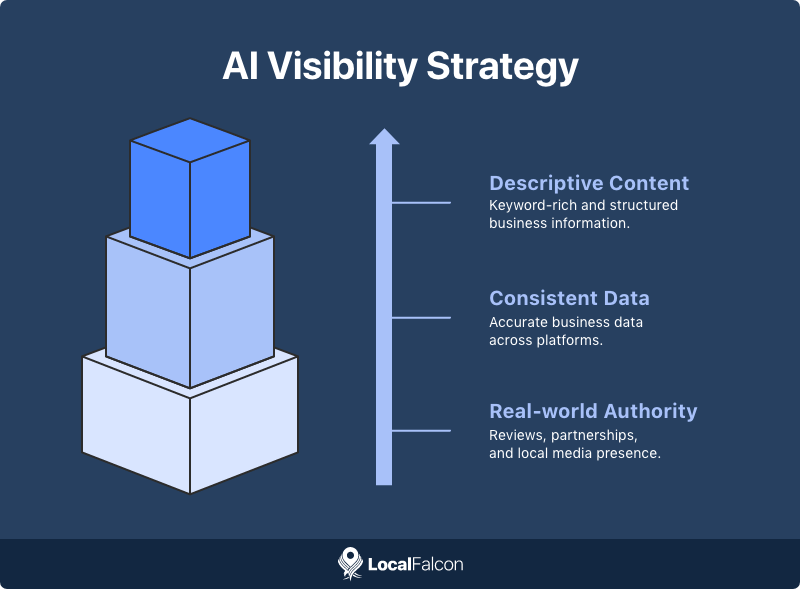Local SEO isn't just about optimizing for the local pack anymore. Sure, ranking in Google Search and Maps is still hugely important, but AI local search tools are becoming a significant source of local business discovery, making it important to expand our definition of local visibility in 2025.
While businesses could, until relatively recently, measure success in local search purely by looking at map pack and organic rankings, they now must ensure they're showing up wherever their customers are searching online, including in AI-generated results. Comprehensive local visibility now spans traditional search, conversational AI, and multi-modal platforms.
AI Local Search in 2025: From Rankings to Reach
In traditional local SEO, visibility has long been tied to a few key, Google-centric metrics: ranking in the Google local pack, showing up in organic (blue-link) results, and converting traffic from local keywords into clicks, calls, appointments, and visits.
However, AI is quickly changing the nature of local discovery, creating new opportunities for business exposure and potentially reducing traditional local search traffic for many businesses.
Across industries, potential customers are increasingly turning to ChatGPT and other AI copilots for natural-language searches, many of them with local intent (think someone asking ChatGPT for detailed restaurant or activity suggestions in a particular city or neighborhood).
Even though AI can sometimes respond with an answer that includes a map and a numbered list that looks an awful lot like a local pack, there's also a high possibility that an answer is provided in complete natural language. Not only that, but an answer can be totally different for a different person performing a very similar query.
In this context, there's no first, second, or third place in AI-generated answers like there is in traditional local search. Of course you can still get mentioned before or after another business, but what's most important is whether or not you're included in the response at all.
The frequency and geographic breadth with which your business is mentioned in AI-generated answers, or your local AI visibility, is a new measure of success that matters more every day. The more you're mentioned, the higher your Share of AI Voice (SAIV).

Traditional and AI Local Search Visibility: The Two Pillars of Comprehensive Local Visibility
1. Traditional Local Search Visibility
Despite the increased popularity of AI as a local search tool, ranking in Google's local pack, on Google Maps, in localized organic results, and across other traditional local search platforms, like Apple Maps and Bing, is still essential.
Even though it's inevitable that Google will lose some search traffic to AI answer engines, the company continues to dominate local search, and Google Business Profile remains one of the most critical assets for any location-based business.
Simultaneously, Apple Maps is gaining traction, especially among iPhone users who default to the iOS-native platform to find nearby businesses. With more consumers relying on Apple's navigation and discovery features, your Apple Business Connect presence and Apple Maps rankings matter more than ever.
These platforms provide visibility that is not only measurable but also transactional, often leading directly to phone calls, bookings, and visits. And importantly, strong performance in traditional local search can support your visibility in AI platforms, since many AI tools still reference, learn from, or are indirectly informed by this data.
In short, traditional rankings are still foundational to comprehensive local visibility, not just for the direct traffic they bring, but for the broader digital footprint they help reinforce across the increasingly AI-powered local search ecosystem.
2. AI Local Search Visibility
AI visibility refers to how often and how reliably a business is mentioned in AI-generated responses to local and informational queries, whether those mentions are happening in ChatGPT, Google's AI Overviews, AI Mode, Gemini, Grok, or another conversational platform.
Unlike traditional search visibility, which is primarily tied to a specific business category or keyword and a specific ranking, AI visibility is more contextual, fluid, and highly dependent on how well the AI understands your business in relation to the user's intent. This visibility isn't just about being at the top of a list, but rather it's about being part of the conversation.
In some responses, a business may be named outright as a recommendation. In others, it may be referenced as an example or included as one of several options. And, in many cases, the response won't follow a predictable format. There might be no numbered list, no map, no external links, just a natural-language paragraph that either includes your business or doesn't.
Because these answers are generated in real time, AI visibility is also probabilistic rather than fixed. Your business might be included in one answer and left out in another version of the same question, depending on small variations in phrasing, user context, or geographic targeting. That's why frequency and consistency of mentions across many queries and locations is becoming the more meaningful benchmark for AI visibility.
To be visible in this environment, businesses must be recognized by AI as a trusted, relevant, and meaningful option for a specific type of customer need. In that sense, AI visibility is an emerging expression of digital authority. It reflects not only how optimized your business listings and website are, but also how confidently an AI assistant can recommend or reference you as part of a useful, personalized response.

From Algorithm Optimization to Understanding
A core shift in local search in 2025 is that AI has made it so it's no longer all about trying to reverse-engineer an algorithm to optimize for it and boost rankings (though this still plays an important role in traditional local search visibility). Improving your AI visibility requires helping large language models (LLMs) understand your business well enough to suggest it to real people.
In practice, that means you need:
- Descriptive, keyword-rich, and structured content that clearly signals what you do and where you do it.
- Accurate, consistent business data across all platforms and directories.
- Real-world authority earned through reviews, testimonials, partnerships, local media, etc.
It also means businesses need to optimize for entities, not just keywords. AI models understand the world through entities (people, places, things) and their relationships. If your business is consistently described in relation to relevant services, neighborhoods, and customer needs, AI is more likely to include you in a local recommendation.
The good news is that this doesn't mean you have to overhaul your local SEO strategy. Many traditional optimization tactics, from creating hyperlocal service pages to collecting reviews across platforms beyond Google, can help boost your AI visibility as well.

How Can You Track AI Local Search Visibility?
Local Falcon offers AI visibility tracking that helps businesses see whether and where they're being mentioned by AI tools and features, including ChatGPT, Google AI Overviews, Google AI Mode, Gemini, and Grok, with more to come.
Instead of staying in the dark about your brand's presence in AI-generated responses, you can start visually measuring your AI search visibility across any geographic area with Local Falcon's signature geo-grid rank tracking scans, just like you would for your Google Business Profile or Apple Business Connect rankings.
This level of insight into your local visibility is critical in 2025, as more potential customers turn to conversational AI for business recommendations and locally relevant information.
Tracking your mentions across different locations and comparing them with your traditional local search performance can help you understand the bigger picture of how your business is being discovered and where you may need to expand your digital footprint to keep up with competitors.
Additionally, Local Falcon's AI visibility intelligence reports include detailed source information, so you can see exactly what sites, platforms, or types of content are driving AI visibility and optimize your presence on those sources to improve your Share of AI Voice.
While AI visibility tracking is still an emerging field, Local Falcon is helping to bring structure and clarity to this exciting new aspect of local search!


